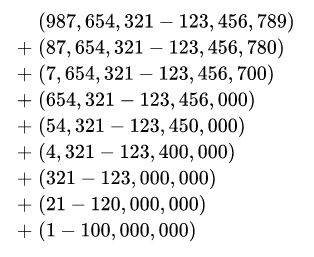Remove one add one

What is the value of the number above?
This problem was adapted from a 1965 book.
The answer is 0.
This section requires Javascript.
You are seeing this because something didn't load right. We suggest you, (a) try
refreshing the page, (b) enabling javascript if it is disabled on your browser and,
finally, (c)
loading the
non-javascript version of this page
. We're sorry about the hassle.
4 solutions
Moderator note:
Great use of "partitioning" the terms. Well done.
Thank you! Very nice. I adapted this problem from Raymond F. Lausmann’s book: Fun With Figures.
Log in to reply
Oh , Thanks for sharing this nice problem with us. ⌣ ¨
@Calvin Lin @Pi Han Goh , Is my solution correct?
Log in to reply
Yes it is! Did the same!
Your solution is very elegant. I did it in the same way.
Consider the positive part on one side and negative part on other side. So for the unit's place, considering there are 9 1's at the left and 1 9 at the right, it leads to =9x1 - 1x9=0 For ten's place, there are 8 2's at the left and 2 8's at the right, it leads to= 8x2 - 2x8=0 Similarly for hundred's place, 7x3 -3x7=0 We keep on doing this and at the end, we get the result as 0.
when you get this type of problem that is in series always remember ans will be 1or 0
The last digit is 1 by substraction with 1 the final solution is 0;hence the problem is solved
Moderator note:
You have only shown that the last digit is 0. You did not show that the number equals to 0 itself.
The left column can be represented as :
( 1 ) [ 9 ( 1 0 8 ) ] + ( 2 ) [ 8 ( 1 0 7 ) ] + ( 3 ) [ 7 ( 1 0 6 ) ] + ⋯ + ( 8 ) [ 2 ( 1 0 1 ) ] + ( 9 ) [ 1 ( 1 0 0 ) ] = n = 1 ∑ 9 n ( 1 0 − n ) ( 1 0 n − 1 )
The right column can be represented as:
( 9 ) [ 1 ( 1 0 8 ) ] + ( 8 ) [ 2 ( 1 0 7 ) ] + ( 7 ) [ 3 ( 1 0 6 ) ] + ⋯ + ( 2 ) [ 8 ( 1 0 1 ) ] + ( 1 ) [ 9 ( 1 0 0 ) ] = n = 1 ∑ 9 ( 1 0 − n ) ( n ) ( 1 0 n − 1 )
This clearly proves that the given expression is 0 .